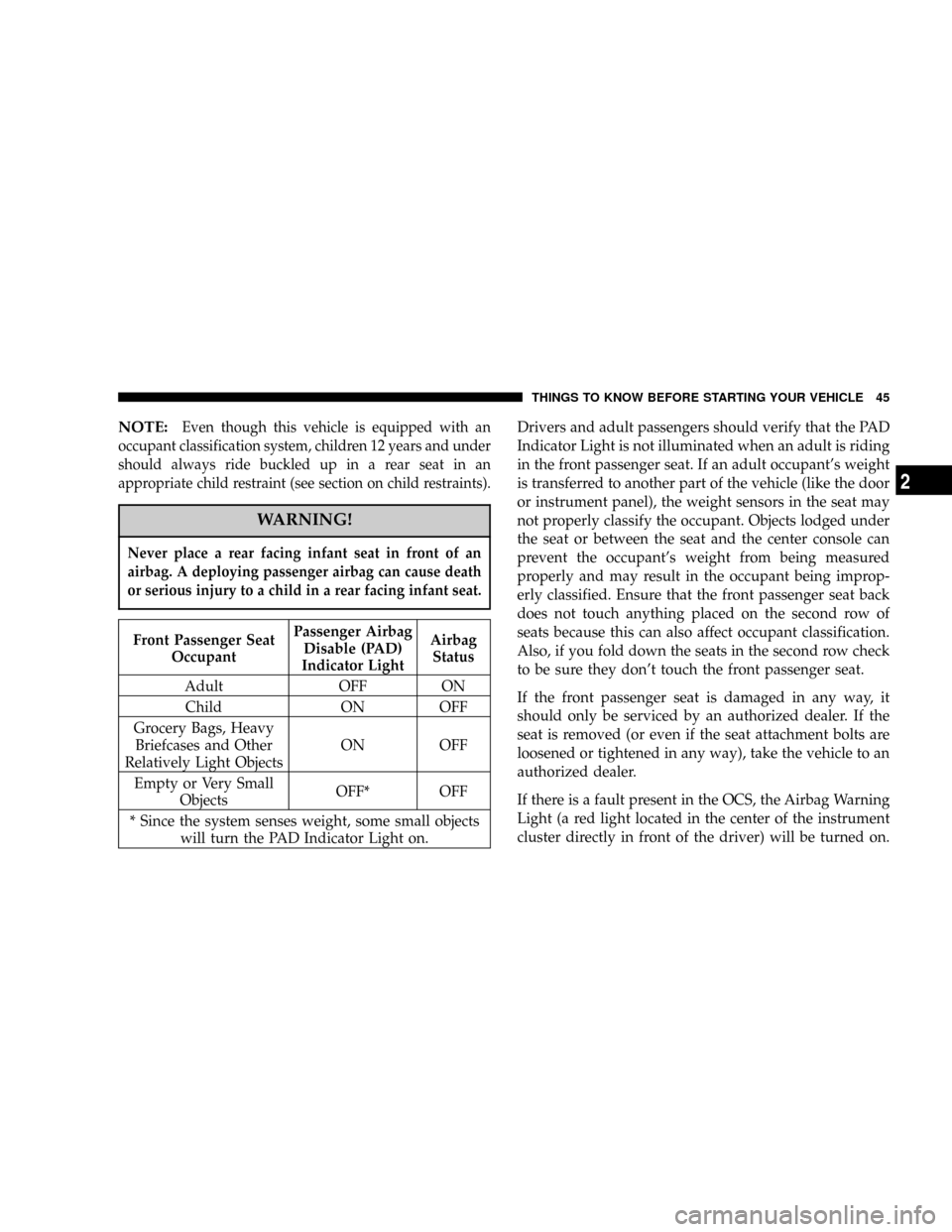child seat DODGE CALIBER 2006 1.G Owners Manual
[x] Cancel search | Manufacturer: DODGE, Model Year: 2006, Model line: CALIBER, Model: DODGE CALIBER 2006 1.GPages: 322, PDF Size: 5.99 MB
Page 8 of 322

NProgramming Additional Transmitters........22
NGeneral Information....................23
NBattery Replacement....................23
mSecurity Alarm System Ð If Equipped.......24
NTo Set The Alarm......................24
NTo Disarm The System...................25
NSecurity System Manual Override...........25
mLiftgate..............................26
mPower Windows........................27
NPower Window Switches.................27
NAuto Down..........................28
NWindow Lockout Switch.................28
mOccupant Restraints.....................29
NLap/Shoulder Belts.....................30
NAdjustable Upper Shoulder Belt Anchorage....34NSecond Row Center Lap/Shoulder Belt
Operating Instructions...................35
NLap/Shoulder Belt Untwisting Procedure.....37
NSeat Belt Pretensioners...................37
NEnhanced Driver Seat Belt Reminder System
(BeltAlert)...........................37
NSeat Belts And Pregnant Women............38
NDriver And Front Passenger Supplemental
Restraint System (SRS) - Airbag............39
NChild Restraint........................52
mEngine Break-In Recommendations..........59
mSafety Tips............................60
NExhaust Gas..........................60
NSafety Checks You Should Make Inside The
Vehicle..............................60
NPeriodic Safety Checks You Should Make
Outside The Vehicle....................61
8 THINGS TO KNOW BEFORE STARTING YOUR VEHICLE
Page 29 of 322

OCCUPANT RESTRAINTS
Some of the most important safety features in your
vehicle are the restraint systems. These include the front
and rear seat belts for the driver and all passengers, front
airbags for both the driver and front passenger and if
equipped, side airbags for both the driver and front
passenger. If you will be carrying children too small for
adult-size seat belts, your seat belts or the LATCH feature
also, can be used to hold infant and child restraint
systems.If your vehicle is equipped with the Occupant Classifi-
cation System (OCS) there will be a Passenger Airbag
Disabled (PAD) Indicator Light located on the center of
the instrument panel.
Please pay close attention to the information in this
section. It tells you how to use your restraint system
properly to keep you and your passengers as safe as
possible.
WARNING!
In a collision, you and your passengers can suffer
much greater injuries if you are not properly buck-
led up. You can strike the interior of your vehicle or
other passengers, or you can be thrown out of the
vehicle. Always be sure you and others in your
vehicle are buckled up properly.
Buckle up even though you are an excellent driver, even
on short trips. Someone on the road may be a poor driver
and cause a collision that includes you. This can happen
far away from home or on your own street.
Lock Out Switch
THINGS TO KNOW BEFORE STARTING YOUR VEHICLE 29
2
Page 37 of 322

Lap/Shoulder Belt Untwisting Procedure
Use the following procedure to untwist a twisted lap/
shoulder belt.
1. Position the latch plate as close as possible to the
anchor point.
2. At about 6 to 12 inches (15 to 30 cm) above the latch
plate, grasp and twist the belt webbing 180É to create a
fold that begins immediately above the latch plate.
3. Slide the latch plate upward over the folded webbing.
The folded webbing must enter the slot at the top of the
latch plate.
4. Continue to slide the latch plate up until it clears the
folded webbing.
Seat Belt Pretensioners
The seat belts for both front seating positions are
equipped with pretensioning devices that are designed to
remove slack from the seat belt in the event of a collision.
These devices improve the performance of the seat belt
by assuring that the belt is tight about the occupant early
in a collision. Pretensioners work for all size occupants,
including those in child restraints.
NOTE:These devices are not a substitute for proper
seat belt placement by the occupant. The seat belt still
must be worn snugly and positioned properly.
The pretensioners are triggered by the front airbag con-
trol module (see Airbag Section). Like the front airbags,
the pretensioners are single use items. After a collision
that is severe enough to deploy the airbags and preten-
sioners, both must be replaced.
Enhanced Driver Seat Belt Reminder System
(BeltAlert)
If the driver's seat belt has not been buckled within 60
seconds of starting the vehicle and if the vehicle speed is
greater than 5 mph (8 km/h), the Enhanced Warning
System (BeltAlert) will alert the driver to buckle their seat
belt. The driver should also instruct all other occupants to
buckle their seat belts. Once the warning is triggered, the
Enhanced Warning System (BeltAlert) will continue to
chime and flash the Seat Belt Warning Light for 96 seconds
or until the driver's seat belt is buckled. The Enhanced
Warning System (BeltAlert) will be reactivated if the driv-
er's seat belt is unbuckled for more than 10 seconds and the
vehicle speed is greater than 5 mph (8 km/h).
THINGS TO KNOW BEFORE STARTING YOUR VEHICLE 37
2
Page 40 of 322

WARNING!
²Do not put anything on or around the airbag
covers or attempt to manually open them. You
may damage the airbags and you could be injured
because the airbags are not there to protect you.
These protective covers for the airbag cushions are
designed to open only when the airbags are in-
flating.
²If your vehicle is equipped with side airbags, do
not use accessory seat covers or place objects
between you and the side airbags; the perfor-
mance could be adversely affected and/or objects
could be pushed into you, causing serious injury.
²If your vehicle is equipped with side airbags, do
not attach cup holders or any other objects on or
around the door. The inflating side airbag could
drive the object into occupants, causing serious
injury.
Airbags inflate in moderate to high speed impacts. Along
with seat belts and pretensioners, front airbags work with
the driver inflatable knee blocker to provide improved
protection for the driver and front passenger. Side airbags
also work with seat belts to improve occupant protection.
The seat belts are designed to protect you in many types
of collisions. The front airbags deploy in moderate to
severe frontal collisions. If your vehicle is equipped, the
side airbag on the crash side of the vehicle is triggered in
moderate to severe side collisions. In certain types of
collisions, both the front and side airbags may be trig-
gered. But even in collisions where the airbags work, you
need the seat belts to keep you in the right position for
the airbags to protect you properly.
NOTE:The passenger front airbag may not deploy
even when the driver front airbag has if the Occupant
Classification System (refer to9Occupant Classification
System9in this section) has determined the passenger
seat is empty or is occupied by someone that is classified
in the ªchild9category. This could be a child, a teenager,
or even a small adult.
40 THINGS TO KNOW BEFORE STARTING YOUR VEHICLE
Page 41 of 322

Here are some simple steps you can take to minimize the
risk of harm from a deploying airbag.
1.Children 12 years old and under should always ride
buckled up in a rear seat.
Infants in rear facing child restraints shouldNEVERride
in the front seat of a vehicle with a passenger front airbag.
An airbag deployment can cause severe injury or death to
infants in that position.
Children that are not big enough to properly wear the
vehicle seat belt (see Section on Child Restraints) should
be secured in the rear seat in child restraints or belt-
positioning booster seats. Older children who do not use
child restraints or belt-positioning booster seats should
ride properly buckled up in the rear seat. Never allow
children to slide the shoulder belt behind them or under
their arm.
If a child from 1 to 12 years old must ride in the front
passenger seat because the vehicle is crowded, move the
seat as far back as possible, and use the proper child
restraint. Refer to the section on Child Restraint.You should read the instructions provided with your
child restraint to make sure that you are using it properly.
2.All occupants should wear their lap and shoulder
belts properly.
3.The driver and front passenger seats should be
moved back as far as practical to allow the front airbags
room to inflate.
4.If your vehicle has side airbags, do not lean against
the door, airbags will inflate forcefully into the space
between you and the door.
5. If the airbag system in this vehicle needs to be
modified to accommodate a disabled person, contact the
Customer Center. Phone numbers are provided under9If
You Need Assistance9in Section 9 of this manual.
THINGS TO KNOW BEFORE STARTING YOUR VEHICLE 41
2
Page 44 of 322

NOTE:Children 12 years and under should always ride
buckled up in a rear seat in an appropriate child restraint.
²The OCS classifies an occupant using weight sensors
mounted in the base of the front passenger seat. Any
weight on the seat will be sensed by the system.
Objects hanging on the seat or other passengers push-
ing down on the seat will also be sensed. The weight of
an adult will cause the system to turn the airbag on. In
this case, the OCS has classified the occupant of the
seat as an adult. An adult occupant needs to sit in a
normal position (with their feet on or near the floor) in
order to be properly classified. Reclining the seat back
too far may change how an occupant is classified by
the OCS.
²ThePassenger Airbag Disabled (PAD) Indicator
Light(an amber light located in the center of the
instrument panel) tells the driver and front passenger
when the front passenger airbag is turned off. The
PAD Indicator lamp illuminates the words9PASS AIR
BAG OFF9to show that the front passenger airbag will
not inflate during a collision requiring airbags. When
the right front passenger seat is empty or when verylight objects are placed on the seat, the passenger air
bag will not inflate even though the Passenger Airbag
Disable (PAD) indicator lamp is not illuminated.
The PAD indictor light should not be illuminated
when an adult passenger is properly seated in the
front passenger seat. In this case, the air bag is ready to
be inflated if a collision requiring an airbag occurs.
For all other occupants, the PAD indicator light will be
illuminated indicating that the front passenger airbag
is turned off and will not inflate.Passenger Airbag Disabled Light
44 THINGS TO KNOW BEFORE STARTING YOUR VEHICLE
Page 45 of 322

NOTE:Even though this vehicle is equipped with an
occupant classification system, children 12 years and under
should always ride buckled up in a rear seat in an
appropriate child restraint (see section on child restraints).
WARNING!
Never place a rear facing infant seat in front of an
airbag. A deploying passenger airbag can cause death
or serious injury to a child in a rear facing infant seat.
Front Passenger Seat
OccupantPassenger Airbag
Disable (PAD)
Indicator LightAirbag
Status
Adult OFF ON
Child ON OFF
Grocery Bags, Heavy
Briefcases and Other
Relatively Light ObjectsON OFF
Empty or Very Small
ObjectsOFF* OFF
* Since the system senses weight, some small objects
will turn the PAD Indicator Light on.Drivers and adult passengers should verify that the PAD
Indicator Light is not illuminated when an adult is riding
in the front passenger seat. If an adult occupant's weight
is transferred to another part of the vehicle (like the door
or instrument panel), the weight sensors in the seat may
not properly classify the occupant. Objects lodged under
the seat or between the seat and the center console can
prevent the occupant's weight from being measured
properly and may result in the occupant being improp-
erly classified. Ensure that the front passenger seat back
does not touch anything placed on the second row of
seats because this can also affect occupant classification.
Also, if you fold down the seats in the second row check
to be sure they don't touch the front passenger seat.
If the front passenger seat is damaged in any way, it
should only be serviced by an authorized dealer. If the
seat is removed (or even if the seat attachment bolts are
loosened or tightened in any way), take the vehicle to an
authorized dealer.
If there is a fault present in the OCS, the Airbag Warning
Light (a red light located in the center of the instrument
cluster directly in front of the driver) will be turned on.
THINGS TO KNOW BEFORE STARTING YOUR VEHICLE 45
2
Page 47 of 322

²TheSide Impact (SRS) Side Curtain Airbags (If
equipped)are designed to activate only in certain side
collisions.
The ORC module determines if a side collision is
severe enough to require the side airbags to inflate.
The side airbag control module will not detect roll
over, front or rear collisions.
The ORC Module monitors the readiness of the elec-
tronic parts of the system whenever the ignition switch
is in the START or ON positions. These include all of
the items previously mentioned.
In moderate to severe side collisions, the side airbag
inflator on the crash side of the vehicle is triggered,
releasing a quantity of nontoxic gas. The side curtain
airbag moves at a very high speed and with such a
high force, that it could injure you if you are not seated
properly, or if items are positioned in the area where
the side curtain airbag inflates. This especially applies
to children.
NOTE:If your vehicle is equipped with left and right
side curtain air bags, do not install a clothing barmounted to the coat hooks (or similarly mounted). A
clothing bar will impede the proper performance of the
bags.
²When the ORC and the impact sensors detect a
collision requiring theDriver Inflatable Knee Blocker
, it signals the inflator unit. A quantity of nontoxic gas
is generated to inflate the Driver Inflatable Knee
Blocker. The Driver Inflatable Knee Blocker inflates
rearward towards the driver's knees to help protect
the knees and position you for the best interaction
with the front airbag. The Driver Inflatable Knee
Blocker fully inflates in about 50 milliseconds, this is
only about half of the time it takes you to blink your
eyes. It then quickly deflates while helping to protect
the driver's knees.
²TheKnee Impact Bolstershelp protect the knees, and
position everyone for the best interaction with the
front airbag.
The front passenger seat assembly contains critical com-
ponents that affect the front passenger airbag deploy-
ment. Correctly functioning front passenger seat compo-
nents are critical for the Occupant Classification System
THINGS TO KNOW BEFORE STARTING YOUR VEHICLE 47
2
Page 52 of 322

²Accelerator status (including vehicle speed)
²Engine control status (including engine speed)
²Cruise control status
²Traction/stability control status
Child Restraint
Everyone in your vehicle needs to be buckled up at all
times Ð babies and children, too. Every state in the
United States and all Canadian provinces require that
small children ride in proper restraint systems. This is the
law, and you can be prosecuted for ignoring it.
Children 12 years and under should ride properly buck-
led up in a rear seat, if available. According to crash
statistics, children are safer when properly restrained in
the rear seats, rather than in the front.
WARNING!
In a collision, an unrestrained child, even a tiny
baby, can become a missile inside the vehicle. The
force required to hold even an infant on your lap
could become so great that you could not hold the
child, no matter how strong you are. The child and
others could be badly injured. Any child riding in
your vehicle should be in a proper restraint for the
child's size.
Infants And Small Children
There are different sizes and types of restraints for
children from newborn size to the child almost large
enough for an adult safety belt. Always check the child
seat owner's manual to ensure you have the correct seat
for your child. Use the restraint that is correct for your
child:
²Safety experts recommend that children ride
rearward-facing in the vehicle until they are at least
one year old and weigh at least 20 lbs (9 kg). Two types
of child restraints can be used rearward-facing: infant
52 THINGS TO KNOW BEFORE STARTING YOUR VEHICLE
Page 53 of 322

carriers and9convertible9child seats. Both types of
child restraints are held in the vehicle by the lap/
shoulder belt or the LATCH child restraint anchorage
system.
²The infant carrier is only used rearward-facing in the
vehicle. It is recommended for children who weigh up
to about 20 lbs (9 kg).9Convertible9child seats can be
used either rearward-facing or forward-facing in the
vehicle. Convertible child seats often have a higher
weight limit in the rearward-facing direction than
infant carriers do, so they can be used rearward-facing
by children who weigh more than 9 kg (20 lbs) but are
less than one year old.
²Rearward-facing child seats mustNEVERbe used in
the front seat of a vehicle with a front passenger
airbag. An airbag deployment could cause severe
injury or death to infants in this position.
²Children who weigh more than 20 lbs (9 kg) and who
are older than one year can ride forward-facing in the
vehicle. Forward-facing child seats and convertible
child seats used in the forward-facing direction are for
children who weigh 20 to 40 lbs (9 to 18 kg) and who
are older than one year. These child seats are also held
in the vehicle by the lap/shoulder belt or the LATCH
child restraint anchorage system.
²The belt-positioning booster seat is for children weigh-
ing more than 40 lbs (18 kg), but who are still too small
to fit the vehicle's seat belts properly. If the child
cannot sit with knees bent over the vehicle's cushion
while the child's back is against the seat back; they
should use a Belt Positioning Booster Seat. The child
and booster seat are held in the vehicle by the lap/
shoulder belt. (Some booster seats are equipped with a
front shield and are held in the vehicle by the lap
portion.)
NOTE:For additional information refer to
www.seatcheck.org.
THINGS TO KNOW BEFORE STARTING YOUR VEHICLE 53
2